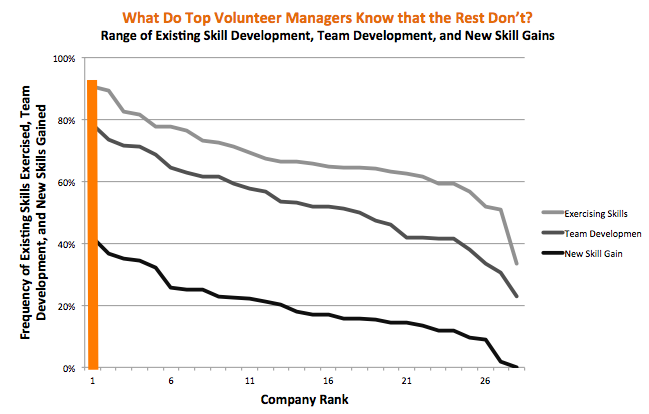This year’s ROI Tracker participants generated more than $6.7 million dollars in services to nonprofit partners – but some generated more social and business value than others. Below is the range of new skill development, team relationship gains, and existing skill development from 28 participating companies.
Out of respondents from the top ranked company, 42% gained new, job-related skills from volunteering, compared to 0% from the bottom ranked company. Similarly only 23% of volunteers from the bottom ranked company gained new or strengthened existing team relationships, where 78% of volunteers from the top ranked company reported team gains.

Here are three tips to maximize your volunteer program’s benefit for nonprofit partners, employees, and your company:
1. Increase skill gains by matching volunteers with job-relevant activities
Increase skill development rates by designing activities that match volunteers’ professional growth paths. Not only is skilled volunteerism better for nonprofits, it is linked to higher satisfaction rates among volunteers than traditional volunteerism. As one UPS volunteer explained, “I was the coordinator for our 107 volunteers, coordinating movement of almost 35,000 packages. This role gives me the opportunity to demonstrate organizational, management and leadership skills.”
2. Increase the social value of initiatives by investing in projects that utilize professional skills
Professional volunteerism benefits nonprofits by providing higher value activities and increasing organizational capacity at a greater frequency than traditional volunteerism. For example, just one percent of the total time volunteered produced five percent of the total value for nonprofits through general operations support -- a role including board service, policy development and managing operations. Skilled volunteers were more likely to report reducing nonprofit hiring costs and improving organizational efficiency and effectiveness. One volunteer was able to apply her company’s lean manufacturing principles to improve the effectiveness of a Special Olympics competition.
3. Leverage volunteerism to strengthen teams and increase internal networking
In 2011, 46% of respondents gained opportunities for team building and internal networking through volunteerism. Employee volunteer programs are an opportunity to increase social capital among and across teams and develop a more engaged and collaborative institutional culture. As one volunteer explained, “I met HQ staff whose names I recognized only on email. It was terrific to stand shoulder to shoulder with them in an effort to complete the project. I had the opportunity to relate to them in an different way.”
For more on the social, employee, and business impacts of volunteerism, download the 2011 Volunteer Tracker Global Summary:



.png)